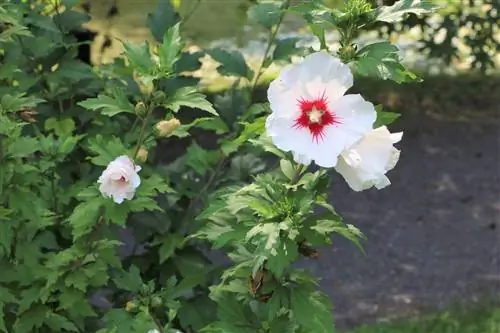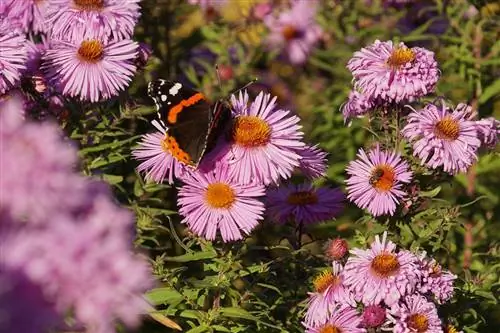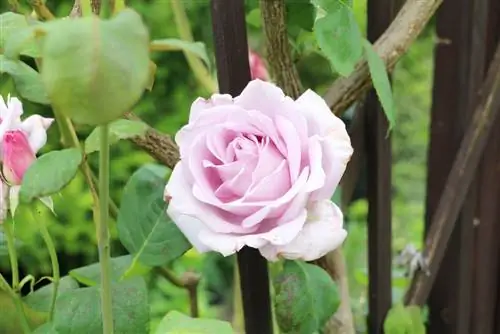- Author admin [email protected].
- Public 2023-12-17 03:39.
- Last modified 2025-01-24 12:45.
The shrub plant not only has to be placed in the optimal location so that it grows he althy and strong. In addition to watering, the right waste also plays an important role. Even if the marshmallow is considered hardy, it is not advisable to simply leave it to its own devices during the cold months. That doesn't sit well with him. When caring for it, make sure there is sufficient nutrient supply and the Syrian marshmallow should also have enough light.
General
In addition to the general name “hibiscus”, this plant is also known as rose marshmallow, Syrian marshmallow and shrub marshmallow. Last but not least, there is the garden hibiscus. It differs from the other species in that it is hardy. This marshmallow reaches a height of between 100 and 150 centimeters. The width varies, although this is often the same as the height.
Watering
The rose marshmallow needs a lot of water, especially on warm days. However, you should make sure to protect the location from waterlogging. Water not consumed by the plant leads to damage, such as rotten roots. It is not enough just to water the marshmallow when the soil is dry. The soil should be constantly moist. To do this, you need to water every day, maybe even several times a day. Add the water as low as possible to the bottom and avoid getting the flowers wet, otherwise dark spots can form.
Fertilize
In the months from April to October, fertilize the rose marshmallow several times a week - two to three times are enough. It is best to use a liquid fertilizer for this. Mature compost provides sufficient nutrients. Slow-release fertilizer can also be given; ideally in the early months of April and May. The hibiscus grows during this time. With the support of fertilizer, growth goes even better.
Removing faded flowers
Dead flowers and leaves rob the rose marshmallow of a lot of strength. Therefore, to maintain the he alth of the plant, it is essential to remove dead parts. Carefully break off the dead parts.
Tip:
Don't cut off the dead flowers, but break them off the plant. When cutting, you may remove new flowers.
Cutting
Pruning is a blessing for the rose marshmallow. Cutting is not only a must for the appearance, but also for maintaining the he alth and lifespan of the plant. They have different types of cuts. The so-called training pruning involves removing diseased and weak shoots, both from older and young plants. This way you give the marshmallow the chance to grow stronger shoots. It is best to make this cut in February. Be careful not to cut the main trunk, only the outgrowths around it.
The maintenance cut serves to beautify an existing flower crown. Weak and dead branches are cut off and thin branches are shortened to the first buds. You certainly want to maintain a beautiful growth habit. To do this, remove the shoots, which visually deform the crown. You also have the option to extend the flowering period. To do this, separate the flowers from the previous year; Remove around a third. Shoots that are too large and old and weak growths are removed when rejuvenating. You can also shorten the remaining shoots by two thirds.
Tip:
Do the pruning in winter. You should have done the pruning by March at the latest, otherwise the marshmallow will only have a few flowers.
Wintering
You can keep the rose marshmallow indoors or outdoors. If your plant is outside in the garden, it is advisable to make a cut beforehand. Do not shorten the shoots too much, but only remove the weaker tips. In the following months the marshmallow will recover and provide new energy. In spring you will be rewarded with even more beautiful flowers. The resulting cuts make the shrub bushier and fuller. Then carefully place the plant in a pot and place it in a room for the wintering period. The place must be cool, with the temperature being around 13 degrees at best. You also have to make sure that the parking space is not too dark. Choose a bright room. If the hibiscus is too dark, there is a high chance that it will lose its flowers in winter. During the winter, you don't need to water the plant as often as you normally do. Only water the soil every now and then. It is important that the marshmallow does not dry out, but also that it is not too moist. Rather, you don't have to pay any attention to wintering. Here are the tips for quick readers again:
- blend beforehand
- Room must be cool but bright
- don’t water so often
Diseases
The leaf spot fungus causes irregular brown spots to appear on the flowers. These can be a sign of the disease. If you find leaf thickening, move the plant to a warmer place. Other dangers include aphids and chlorosis, which causes the leaves to turn yellow.
Frequently asked questions
My hibiscus has brown spots. What could that be?
It is possible that you accidentally watered the flowers while watering them. Make sure that you water as close to the ground as possible so as not to water the shoots. Otherwise, the plant may be affected by a disease, for example leaf spot fungus.
The plant is wilting. What could be the reasons for this?
Although it is important to water the marshmallow often and sufficiently, the plant must not stand in water. If you give too much water, it is possible that waterlogging will occur. This usually leads to rotten roots. Another possibility is that you have not yet undertaken the necessary care. Check whether the plant still has old shoots. If this is the case, remove old, weak and dead parts to give the marshmallow the strength it needs.
What you should know about rose marshmallow in brief
Location
- The hibiscus is a sun lover and enjoys a location in full sun. Partial shade is tolerated if the location is really warm.
- He would like a protected place where he is not too harassed by other plants.
- Since the marshmallow enjoys high humidity, a spot near a garden pond or stream is ideal.
- When it comes to soil, it is not very picky and can cope with any normal garden soil that is nutrient-rich and well-drained. Otherwise, the soil should be kept evenly moist, especially during the flowering period. If it is too dry, no flowers will be formed.
- The best time to plant is spring or autumn until the end of September at the most, so that the rose marshmallow takes root before winter.
Care
- The hibiscus needs a lot of water, especially on warm days in summer.
- The soil should always be kept slightly moist, which may require daily watering.
- It's best to only water the soil deeply, if possible don't let the water run over flowers and leaves!
- From around April to October, the marshmallow likes fertilization every two to three weeks.
- It is also sufficient for him to spread mature compost or give slow-release fertilizer at the beginning of the growing season in spring.
- It is advisable to always remove dead flowers. It tolerates breaking out better than cutting it off.
Cutting
- The hibiscus not only tolerates pruning well, it also demands it in order not to age.
- Therefore, it should be cut back heavily once a year, ideally in winter.
- Since the rose marshmallow only blooms on annual wood, it produces very few flowers without pruning and grows extremely sparingly.
- The last date for pruning should be March, before new growth, otherwise you will have to do without the flowers in the same year.
Wintering
- If the rose marshmallow was able to root sufficiently before winter and has grown well, sub-zero temperatures will no longer bother it.
- Young plants in particular are grateful for light winter protection with leaves or brushwood, especially in barfrost (frost without snow).
Propagation
- Hibiscus can be propagated from root cuttings, although this requires a little patience.
- The cuttings are cut to a length of approx. 5 to 8 cm and covered with a little soil.
- The cuttings should be completely covered, but only with a thin layer of soil.
- They should be placed in a separate bed away from other plants so as not to be crowded.
- Don't let the soil dry out too much and cover it with some brushwood in winter.
- The best time to take root cuttings is March.
- However, plants grown this way need two years to develop properly.
Care problems
Overall, the marshmallow is quite sensitive. It quickly takes issue with too little water, waterlogging and a lack of nutrients and often the plant can no longer be saved. If the leaves turn brown starting from the tips of the leaves and fall off, it is usually a sign of waterlogging, dryness, lack of nutrients or even light. To avoid waterlogging, some of the roots should be carefully dug out. If they are brown and muddy, the soil is too compacted and urgently needs to be loosened. These rotting root parts should be removed down to the normal, firm, white roots. However, it is not certain whether he will recover, because the hibiscus easily takes such care errors seriously. If dryness and lack of light can be ruled out, nutrients should be added every 2-3 weeks with a commercial fertilizer.
If the buds or leaves suddenly fall off, it is usually a sign of drought. If the plant does not get enough water, it sheds the buds and leaves to reduce the water requirement. The leaves usually turn yellow and then fall off, a clear indication is when the hibiscus becomes bald from below.






